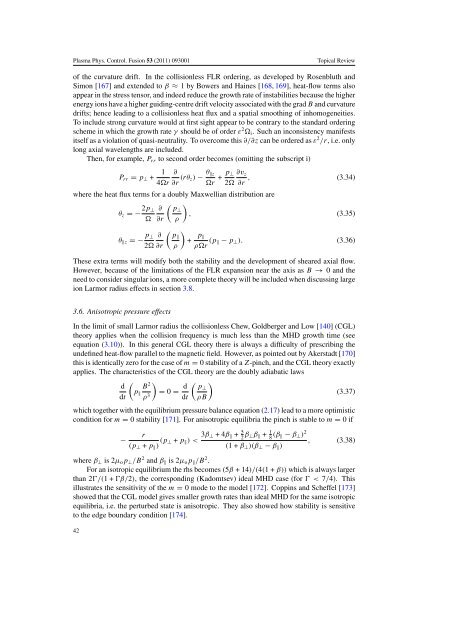Create successful ePaper yourself
Turn your PDF publications into a flip-book with our unique Google optimized e-Paper software.
Plasma Phys. Control. Fusion 53 (2011) 093001<br />
Topical Review<br />
<strong>of</strong> <strong>the</strong> curvature drift. In <strong>the</strong> collisionless FLR ordering, as developed by Rosenbluth and<br />
Simon [167] and extended to β ≈ 1 by Bowers and Haines [168, 169], heat-flow terms also<br />
appear in <strong>the</strong> stress tensor, and indeed reduce <strong>the</strong> growth rate <strong>of</strong> instabilities because <strong>the</strong> higher<br />
energy ions have a higher guiding-centre drift velocity associated with <strong>the</strong> grad B and curvature<br />
drifts; hence leading to a collisionless heat flux and a spatial smoothing <strong>of</strong> inhomogeneities.<br />
To include strong curvature would at first sight appear to be contrary to <strong>the</strong> standard ordering<br />
scheme in which <strong>the</strong> growth rate γ should be <strong>of</strong> order ε 2 i . Such an inconsistency manifests<br />
itself as a violation <strong>of</strong> quasi-neutrality. To overcome this ∂/∂z can be ordered as ε 2 /r, i.e. only<br />
long axial wavelengths are included.<br />
Then, for example, P rr to second order becomes (omitting <strong>the</strong> subscript i)<br />
P rr = p ⊥ + 1 ∂<br />
4r ∂r (rθ z) − θ ‖z<br />
r + p ⊥ ∂v z<br />
2 ∂r , (3.34)<br />
where <strong>the</strong> heat flux terms for a doubly Maxwellian distribution are<br />
θ z =− 2p ⊥<br />
<br />
∂<br />
∂r<br />
θ ‖z =− p ⊥ ∂<br />
2 ∂r<br />
(<br />
p⊥<br />
ρ<br />
(<br />
p‖<br />
ρ<br />
)<br />
, (3.35)<br />
)<br />
+ p ‖<br />
ρr (p ‖ − p ⊥ ). (3.36)<br />
These extra terms will modify both <strong>the</strong> stability and <strong>the</strong> development <strong>of</strong> sheared axial flow.<br />
However, because <strong>of</strong> <strong>the</strong> limitations <strong>of</strong> <strong>the</strong> FLR expansion near <strong>the</strong> axis as B → 0 and <strong>the</strong><br />
need to consider singular ions, a more complete <strong>the</strong>ory will be included when discussing large<br />
ion Larmor radius effects in section 3.8.<br />
3.6. Anisotropic pressure effects<br />
In <strong>the</strong> limit <strong>of</strong> small Larmor radius <strong>the</strong> collisionless Chew, Goldberger and Low [140] (CGL)<br />
<strong>the</strong>ory applies when <strong>the</strong> collision frequency is much less than <strong>the</strong> MHD growth time (see<br />
equation (3.10)). In this general CGL <strong>the</strong>ory <strong>the</strong>re is always a difficulty <strong>of</strong> prescribing <strong>the</strong><br />
undefined heat-flow parallel to <strong>the</strong> magnetic field. However, as pointed out by Akerstadt [170]<br />
this is identically zero for <strong>the</strong> case <strong>of</strong> m = 0 stability <strong>of</strong> a Z-<strong>pinch</strong>, and <strong>the</strong> CGL <strong>the</strong>ory exactly<br />
applies. The characteristics <strong>of</strong> <strong>the</strong> CGL <strong>the</strong>ory are <strong>the</strong> doubly adiabatic laws<br />
d B<br />
(p 2 )<br />
‖ = 0 = d ( )<br />
p⊥<br />
(3.37)<br />
dt ρ 3 dt ρB<br />
which toge<strong>the</strong>r with <strong>the</strong> equilibrium pressure balance equation (2.17) lead to a more optimistic<br />
condition for m = 0 stability [171]. For anisotropic equilibria <strong>the</strong> <strong>pinch</strong> is stable to m = 0if<br />
r<br />
−<br />
(p ⊥ + p ‖ ) (p ⊥ + p ‖ )< 3β ⊥ +4β ‖ + 5 2 β ⊥β ‖ + 1 8 (β ‖ − β ⊥ ) 2<br />
, (3.38)<br />
(1+β ⊥ )(β ⊥ − β ‖ )<br />
where β ⊥ is 2µ o p ⊥ /B 2 and β ‖ is 2µ o p ‖ /B 2 .<br />
For an isotropic equilibrium <strong>the</strong> rhs becomes (5β +14)/(4(1+β)) which is always larger<br />
than 2Ɣ/(1+Ɣβ/2), <strong>the</strong> corresponding (Kadomtsev) ideal MHD case (for Ɣ














